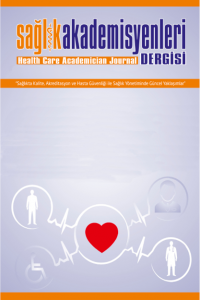Öz
Introduction and Objective: Knowledge comes in many forms. Knowing ability in nursing has been reported to occur in five ways. This review has been prepared in order to explain the importance and use of the ways of knowing in nursing.
Material and Method: In the review, ways of knowing in nursing discussed under the title of five. These; the questioning and criticizing aspect of nursing is free knowing, empirical knowing that reflects research and scientific competence, esthetic knowing which is the art of nursing, ethical knowing which is explaining ethical and moral behaviors in practice and personal knowing. Additionally, the way of knowing five will contribute to the improvement of the knowledge of nursing.
Conclusion: It is recommended that nurses gain ways of knowing and using in practice. The quality of care will increase by teaching these ways of knowing in nursing education program. Besides, it will enable to the patients will receive better treatment from the nurses.
Anahtar Kelimeler
Kaynakça
- Referans1 Sönmez, V. (2013). Bilim Felsefesi: Bilimle İlgili Bazı Kavramlar. Ankara: Anı Yayıncılık.
- Referans2 Velioğlu, P. (2012). Hemşirelikte Kavram ve Kuramlar. İstanbul: Akademi Basın ve Yayıncılık.
- Referans3 Karadağ, A., Çalışkan, N. & Göçmen Baykara, Z. (2017). Hemşirelik Teorileri ve Modelleri. İstanbul: Akademi Basın ve Yayıncılık.
- Referans4 Leddy, S., Pepper, J.M. (1998). Patterns of Knowing and Nursing Science: Conceptual Bases of Professional Nursing. Philadelphia: JB.Lippincott Company.
- Referans5 McKenna, H.P., Slevin, O. (2008). Knowing and Knowledge: Importance for Nursing, Vital Notes for Nurses: Nursing Models, Theories and Practice. Blacwell Publishing, pp.63-87.
- Referans6 Carper, B.A. (1978). Fundamental Patterns of Knowing in Nursing. Advances in Nursing Science, 1, 13-24.
- Referans7 Chinn, P.L., Kramer, M.K. (2013). Integrated Theory and Knowledge Development In Nursing. Mosby: St Louis.
- Referans8 McKenna, H. (1997). Nursing Theories and Models. New York: Taylor & Francis Group.
- Referans9 Sarpkaya, D., Vural, G. (2014). Hemşirelikte Dört Bilme Yolunun Jinekolojik Muayenede Kullanımı. Dokuz Eylül Üniversitesi Hemşirelik Yüksekokulu Elektronik Dergisi, 7, 124-127.
- Referans10 Dossey, A.M. (2008). Theory of integral nursing. Advances in Nursing Science, 31, 52-73.
- Referans11 Yıldırım, A. (2013). Estetik bilme ve hemşirelik. Balıkesir Sağlık Bilimleri Dergisi, 2, 69-76.
- Referans12 Berragan, L. (1998). Nursing practice draws upon several different ways of knowing. Journal of Clinical Nursing, 7, 209–217.
- Referans13 Platin N. (2012). Hemşirelikte Örtük Bilgi. I. Onkoloji Hemşireliği Sempozyumu. Erişim Tarihi: 30.05.2019, www.onkohem.org.tr.
- Referans14 Stankosky, M.A. (2004). Criteria for Measuring Knowledge Management Efforts in Organizations, Ph.D. Dissertation, The George Washington University.
- Referans15 Nonoka, I. (1994). A Dynamic Theory of Organizational Knowledge Creation. Organization Science, 5, 14-37.
- Referans16 Carlsson, G., Drew, N., Dahlberg, K. & Lützen, K. (2002). Uncovering tacit caring knowledge. Nursing Philosophy, 3, 144-151.
Öz
ve Amaç: Bilmenin çeşitli türleri vardır. Hemşirelikte bilme becerisinin beş yol ile meydana geldiği
bildirilmiştir. Bu derleme,
hemşirelikte bilme yollarının kullanımını ve önemini açıklamak amacıyla
hazırlanmıştır.
ve Yöntem: Derlemede, hemşirelikte bilme yolları beş başlık
altında tartışılmıştır. Bunlar; hemşireliğin sorgulayıcı ve eleştiri yapıcı
yönü olan özgür bilme, araştırıcı ve bilimsel yeterliliğini yansıtıcı ampirik bilme, hemşireliğin sanatı olan estetik bilme, uygulamada
etik ve ahlaki davranışları açıklayan etik bilme ve kişisel bilmedir. Ayrıca,
beş bilme yolu hemşirelik bilgisinin gelişimine de katkı sağlayacaktır.
Hemşirelere
bilme yollarını kazanmaları ve uygulamada kullanmaları önerilmektedir. Hemşirelik eğitim programında bu bilme
yollarının öğretilmesi ile bakımın kalitesi artacaktır. Ayrıca,
hastaların hemşirelerden daha iyi tedavi görmelerini sağlayacaktır.
Anahtar Kelimeler
Kaynakça
- Referans1 Sönmez, V. (2013). Bilim Felsefesi: Bilimle İlgili Bazı Kavramlar. Ankara: Anı Yayıncılık.
- Referans2 Velioğlu, P. (2012). Hemşirelikte Kavram ve Kuramlar. İstanbul: Akademi Basın ve Yayıncılık.
- Referans3 Karadağ, A., Çalışkan, N. & Göçmen Baykara, Z. (2017). Hemşirelik Teorileri ve Modelleri. İstanbul: Akademi Basın ve Yayıncılık.
- Referans4 Leddy, S., Pepper, J.M. (1998). Patterns of Knowing and Nursing Science: Conceptual Bases of Professional Nursing. Philadelphia: JB.Lippincott Company.
- Referans5 McKenna, H.P., Slevin, O. (2008). Knowing and Knowledge: Importance for Nursing, Vital Notes for Nurses: Nursing Models, Theories and Practice. Blacwell Publishing, pp.63-87.
- Referans6 Carper, B.A. (1978). Fundamental Patterns of Knowing in Nursing. Advances in Nursing Science, 1, 13-24.
- Referans7 Chinn, P.L., Kramer, M.K. (2013). Integrated Theory and Knowledge Development In Nursing. Mosby: St Louis.
- Referans8 McKenna, H. (1997). Nursing Theories and Models. New York: Taylor & Francis Group.
- Referans9 Sarpkaya, D., Vural, G. (2014). Hemşirelikte Dört Bilme Yolunun Jinekolojik Muayenede Kullanımı. Dokuz Eylül Üniversitesi Hemşirelik Yüksekokulu Elektronik Dergisi, 7, 124-127.
- Referans10 Dossey, A.M. (2008). Theory of integral nursing. Advances in Nursing Science, 31, 52-73.
- Referans11 Yıldırım, A. (2013). Estetik bilme ve hemşirelik. Balıkesir Sağlık Bilimleri Dergisi, 2, 69-76.
- Referans12 Berragan, L. (1998). Nursing practice draws upon several different ways of knowing. Journal of Clinical Nursing, 7, 209–217.
- Referans13 Platin N. (2012). Hemşirelikte Örtük Bilgi. I. Onkoloji Hemşireliği Sempozyumu. Erişim Tarihi: 30.05.2019, www.onkohem.org.tr.
- Referans14 Stankosky, M.A. (2004). Criteria for Measuring Knowledge Management Efforts in Organizations, Ph.D. Dissertation, The George Washington University.
- Referans15 Nonoka, I. (1994). A Dynamic Theory of Organizational Knowledge Creation. Organization Science, 5, 14-37.
- Referans16 Carlsson, G., Drew, N., Dahlberg, K. & Lützen, K. (2002). Uncovering tacit caring knowledge. Nursing Philosophy, 3, 144-151.
Ayrıntılar
| Birincil Dil | Türkçe |
|---|---|
| Konular | Sağlık Kurumları Yönetimi |
| Bölüm | Derleme |
| Yazarlar | |
| Yayımlanma Tarihi | 31 Aralık 2019 |
| Kabul Tarihi | 9 Ekim 2019 |
| Yayımlandığı Sayı | Yıl 2019 Cilt: 6 Sayı: 4 |



